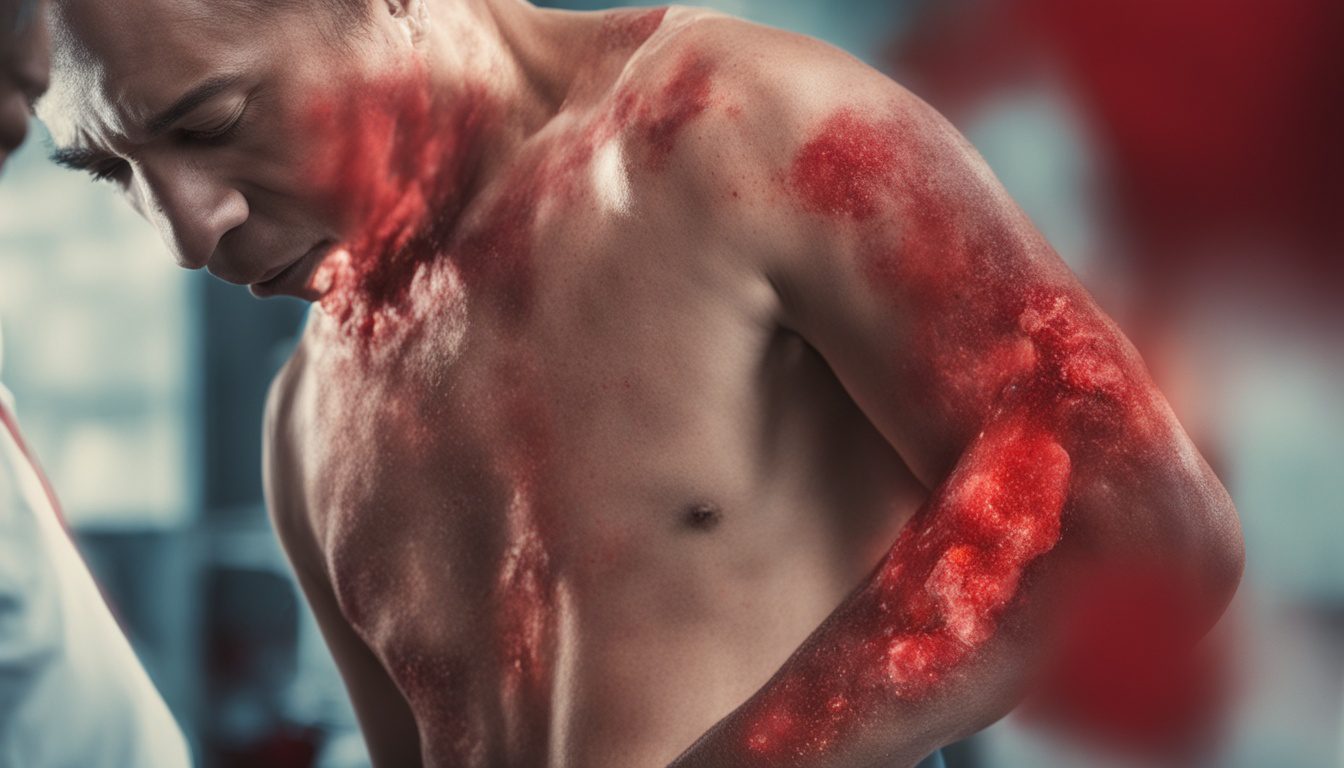Stevens-Johnson syndrome (SJS) and toxic epidermal necrolysis (TEN) are serious skin reactions linked to drugs. They have high mortality rates and severely affect the skin’s outer layer and mucous membranes. Learning about the symptoms, causes, and treatments is key to helping those affected.
It’s not fully clear what causes SJS/TEN. They often happen after taking specific drugs. Some people might have genes that make them more likely to get SJS/TEN. Importantly, not everyone reacts this way to the same drugs.
TEN disease shows in many symptoms, from big blisters to severe skin damage. The eyes also suffer harm. Skin gets red and irritated, and the mouth and private areas can be involved too. Spotting these signs early is very important for quick help.
Doctors figure out if someone has SJS/TEN by looking at their skin and medical history. They do a detailed exam and sometimes take a bit of skin to check more closely. This helps to be sure of the diagnosis.
There isn’t a sure way to cure SJS/TEN yet. But, doctors can help manage the symptoms and care for wounds to stop bad things from happening. Although treatments are limited and these diseases can be deadly, some new studies show that stem cells might help in the future.
Key Takeaways:
- TEN disease includes SJS and TEN, which are severe reactions to some medications.
- Drug use and genetics are behind SJS/TEN.
- Its symptoms vary but may include blistering and skin loss.
- Diagnosis is made through a detailed look at the skin and other tests.
- Stem cells might offer a new hope for treating SJS/TEN.
Drug-Induced Stevens-Johnson Syndrome and Toxic Epidermal Necrolysis.
Drug-induced Stevens-Johnson Syndrome (SJS) and Toxic Epidermal Necrolysis (TEN) are rare but serious skin reactions. They can lead to the skin peeling off, issues in the mouth and eyes, and are life-threatening.
Many medicines might trigger SJS and TEN. Common ones include carbamazepine, nevirapine, lamotrigine, and allopurinol. A closer look found carbamazepine often causes toxic epidermal necrolysis. Plus, drugs like paracetamol, metronidazole, and fluconazole are also linked to SJS and TEN.
Healthcare workers should know these risks and check patients on these drugs closely. If they spot SJS or TEN early and stop the causing drug, outcomes can be better. This can even lower the risk of death.
It’s key for medical workers to understand how some drug reactions can lead to SJS/TEN. This helps them treat their patients better and provide the right kind of care.
Stem Cell Therapy for SJS/TEN.
Stevens-Johnson syndrome (SJS) and toxic epidermal necrolysis (TEN) are both very serious. They happen when our skin reacts badly to drugs. Right now, there aren’t many ways to treat these reactions. But, scientists have seen some hope in treating them with stem cells.
Stem cells, specifically mesenchymal stem cells (MSCs), are getting a lot of interest. They can change how our immune system works and they help our skin and tissue grow back. Plus, they calm down the part of our immune system that goes overboard in SJS/TEN. This might help patients get better faster.
In tests on mice with SJS/TEN, using MSCs showed good results. It made less damage to their eyes and less dead cells in the skin and tissues.
We still need more studies to figure out the best way to use MSCs. Things like how much to use and what might happen over time are important questions. Doing trials with patients will help see if MSCs really can treat SJS/TEN safely and well.
Potential Benefits of Stem Cell Therapy for SJS/TEN
Using stem cell therapy for SJS/TEN could bring a lot of good changes. It could:
- Help skin and tissues grow back
- Make the immune system work better to calm down the skin reaction
- Lessen eye damage and problems
- Make the healing process better overall
Scientists want to use the special abilities of MSCs to offer a new cure for SJS/TEN. But, we need more big tests to be sure it works well and is safe for patients.
Conclusion
SJS and TEN are dangerous skin reactions caused by some drugs. They hurt patients a lot. Right now, doctors don’t have many ways to treat these sicknesses.
There’s new hope with stem cell therapy. MSCs are a type of stem cell. They show promise in treating SJS and TEN. In a study with mice, they helped lower damage to the eyes and stopped cells from dying.
But, we need more research and tests to know if stem cells are really a safe and good treatment for people with SJS and TEN. Doing these studies helps us understand how well stem cell therapy could work, giving hope to those who suffer and making their lives better.

